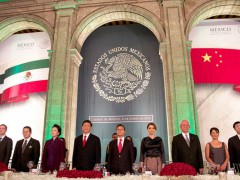Project Dragon Mart: the Collateral Effects of Economic Growth

After a series of contentious legal disputes, in August 2013 Cancun will finally know whether the Chinese “Dragon Mart” will ever come into existence along the coast of Mexico’s most important tourist destination.
The construction of the Dragon Mart business complex (similar to a shopping mall where many huge and médium-sized enterprises exhibit their products and services) is a promising economic prospect for developers, but a rather controversial one for Cancun’s local citizens, small and medium-sized entrepreneurs, and environmental organizations.
The debate on constructing the Dragon Mart along Cancun’s coast is simple: development is not purely an economic issue, – and instead, the decision to build or not to build must weigh considerations of social equity as well as environmental sustainability in order to achieve best outcomes for Mexico’s economic development.
Aimed at strengthening Mexican’s bilateral relation with the Chinese government and establishing Cancun as a strategic link between Latin America and Asia, ownership of the Dragon Mart project would be shared between two Mexican contractors and the Chinamex Middle East Investment Trade Promotion Center – an organization focused on the international promotion of Chinese products.

Photo taken by Mexico´s First Lady, Angélica Rivera Peña. (CC BY-SA 2.0) Available in Flickr.
It shows President Xi Jinping´s recent visit to Mexico mainly for commercial purposes.
The Dragon Mart would be built on 557 hectares supplied only with green resources – such as a waste water treatment plant and 167,000 m2 of solar panels on the roof. It´s a place where 3,040 enterprises would be able to directly negotiate close deals with Asian clients and suppliers, generating an estimated revenue of around 700 million dollars, 8,550 new permanent jobs and attracting one million wealthy business tourists each year to Cancun and its surrounding communities.
On the one hand from a purely economic viewpoint, we can say the more businesses, the better. More jobs, cheaper trade with other countries and rich tourism would increase Mexico’s wealth while the diversification of commercial partners would also aid the country by decreasing its dependency on trade with the USA.
Yet on the other hand, construction of such a complex would entail a series negative environmental consequences in terms of an even bigger amount of waste, increased traffic and possible damage to the “Puerto Morelos Reef” nature reserve only 3.5 km from where Dragon Mart is destined to be built. At the same time, small and medium-sized Mexican entrepreneurs may find themselves harmed by a cheap and strong Chinese market. There is a lack of clear regulation to protect local producers from this sort of competition; in fact, Chinese competitors have already penetrated the textile and footwear industries and the effects have been devastating for local shops.
During Mexico’s elections last July, the issue of sustainable development brought to light the polarized perspectives existing between the various political parties. The PRI (Revolutionary Institutional Party) allied with businessmen accused the left wing of generating a dirty smear campaign and of receiving lobbyists’ money from the Walton Family Foundation.
In return, the left wing PRD (Democratic Revolution Party) supported by civil organizations, accused its opponents of having their own economic stake in the creation of the complex. The Anonymous group claimed to have in its possession a contract that proved that PRI´s representatives would receive a share of the benefits generated by the Dragon Mart.

KamMoon Tong Golden Dragon. Picture taken by DragonPhoenix. (CC BY-SA 3.0) Available in Wikimedia Commons.
But pointing the finger of blame is perhaps not the best option.I think it would be much better if this issue were to be investigated by non-partisan experts who would examine similar cases such as the Dragon Mart in Dubai or analyze why a similar project called Fanerdun was rejected in Sweden 2007.
Naturally any decision will always have its pros and cons. Even so, when dealing with public policies and these kind of projects it is always essential to weigh up the possible consequences and try to foresee the long-term effects.
Once this step is accomplished, it will be time to mediate between both parties and find solutions to the challenges of sustainable development. The project must adapt to regional requirements rather than simply forging ahead with what has worked in other regions.
Is the economy more important than society? Is society more important than the environment? Is it even possible to measure and compare the importance of each set of interests? I think it is not, and that’s the main reason why, leaving aside what the final decision in August might be, the case of the Dragon Mart must be considered as a precedent for regulating further foreign investment, sustainable development, environmental protection, and civil participation.
For more information about the ecologic impact of the Project, read the Greenpeace official position. (In Spanish only).
Tags: China, Dragon Mart, economic development, Mexico, sustainable development
